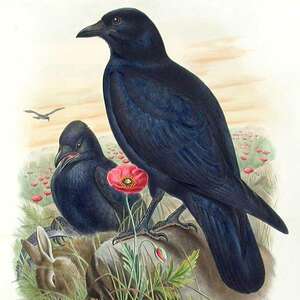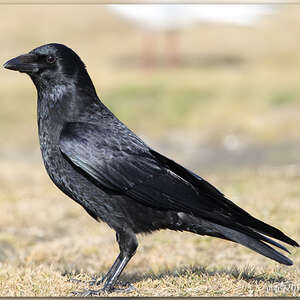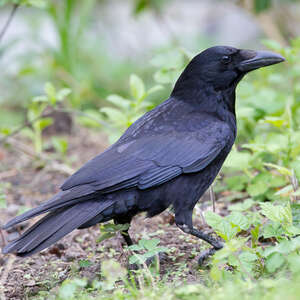Carrion Crow
Corvus corone - Corneille noire
Identification
The Carrion Crow belongs to the corvid family which includes the world's biggest passerines, and within this family to the genus Corvus most of whose members have entirely black plumage. With its scientific name Corvus corone, the Carrion Crow fits the pattern perfectly. Everything about it is black, from the beak tip to the end of its tail and its legs including its eyes. In adults, the new plumage is glossy and can shine in the sunlight with even some blue or green reflections. With wear, it becomes dull, brownish. The sexes are identical. The juvenile can be distinguished by its less tight black plumage, its grayer eye and most of all by the red inside its mouth cavity which can be clearly seen during feedings. Very quickly afterward, it will become similar looking to the adult. In its Eurasian range, the Carrion Crow can be confused with two other black corvids, the Common Raven and the Hooded Crow. The former is bigger, with a stronger beak that makes its head appear smaller by proportion and a longer, wedge-shaped tail extending beyond the wingtip at rest. The latter has a size similar to the Carrion Crow but the adult has a darker gray beak of a different shape (higher at the base and more pointed) with a light gray bare skin area around its base. The tail is longer and wedge-shaped and extends beyond the wingtip at rest. If there is confusion, it is mostly with the juvenile Hooded Crow. Indeed, it has a dark gray beak, with a black plumed base extending over the culmen and hiding the nostrils, much like that of the Carrion Crow. What has to be seen to make the distinction then is the shape of the beak (more pointed in the Hooded Crow), the shape of the skull (often rounder in the Hooded Crow), the tail length (extending beyond the wings in the Hooded Crow) and of course the voice and behaviour (nasal-sounding cries and more gregarious behaviour in the Hooded Crow).At flight, the silhouette of the Carrion Crow is typical, with wings wider and a tail shorter and more rounded than its relatives.
Subspecific information 2 subspecies
- Corvus corone corone (w Europe)
- Corvus corone orientalis (c and e Asia)
Foreign names
- Corneille noire,
- Corneja negra,
- gralha-preta,
- Rabenkrähe,
- kormos varjú,
- Zwarte Kraai,
- Cornacchia nera,
- svartkråka,
- Svartkråke,
- vrana čierna,
- vrána černá,
- Sortkrage,
- (nokivaris),
- cornella negra,
- Svartkráka,
- czarnowron,
- melnā vārna,
- črna vrana,
- Европейская чёрная ворона,
- ハシボソガラス,
- 小嘴乌鸦,
- svartkråka,
- 小嘴鴉〔小嘴烏鴉〕,
Voice song and call
The Carrion Crow is not inconspicuous since it is very vocal. Its voice is unpleasant to the human ear. One cannot speak of singing with corvids, but rather of various cries associated with the relationships between individuals. The usual cry, which can be translated as aaaah or aaaarrh or raaaah, is powerful and characteristic. It is often uttered in a series. It is both a contact cry and a territorial cry by which the pair asserts its presence. It has variants depending on the individual and/or the circumstances. The crow may cry both when perched and when in flight. There is a circumstance where crows in an area loudly express their disapproval, which is when a raptor intrudes, particularly the Buzzard. The cry then takes on a higher tone and frequency. The crows then constantly circle the intruder with loud cries if they are perched or escort them out if they are in flight. It is often in this sound context that one has the best chance of observing the Buzzard, an inherently discreet bird. On the other hand, when it is a buzzard being pursued for fun or for any other reason, the cries are quite different. They are rolled cries, low-pitched rrrrrhh. It can be perceived that the danger is not the same for the crow. The vocal repertoire is quite wide but most of the cries have the same vocal base and are recognizable as such. But there are some that stand out from the ordinary and one may wonder from which throat they come from, such as these high-pitched throat sounds that are reminiscent of some jay cries. The begging cries of the young, of higher pitch, may bring to mind certain Rook cries.
Habitat
The Carrion Crow is a common species, present in all open and semi-open environments, from sea level to alpine level.
Behaviour character trait
The Carrion Crow is a very territorial species during the breeding season and, as the density is often high, territorial conflicts are frequent. In Europe, crows are sedentary and occupy their territory all year round. Knowing the potential longevity of the species which is twenty years, one imagines that young birds must have difficulty finding an unoccupied territory in favourable sectors. As a result, it is common to observe in the nice season groups of immature, non-reproducing and thus non-territorial birds moving, feeding and sleeping together. Outside of the breeding season, the behaviour of the crow is softened.
The birds of one sector cluster together and go about their occupations. They sleep at night in dormitory trees. This gregariousness provides them with protection against predators, as there will always be sentries to detect danger. Crows willingly mix with other corvids, Rooks and jackdaws, as well as locally occurring Ravens, during the internuptial period. The nocturnal dormitories are usually mixed. Corvids are known as birds with developed intelligence. We have examples with the crow. Although it is often very close to humans and their activities, the Carrion Crow nevertheless remains highly mistrustful of them. A sudden or unusual gesture and it takes flight. It is difficult to catch it out. It can see where the danger lies for it. On the other hand, a young Carrion Crow can easily be tamed. It becomes very confident and playful. But beware, it has a particular attraction to the eyes of its admirers and care must be taken of them, for example when it is perched on the shoulder. It is a naturally playful bird.Crows have already been observed sliding down snowy or icy roofs like a skier on a ski slope. Another example, it is quite common to observe Carrion Crows hanging upside down by their feet to a branch or wire, apparently for enjoyment (see photo gallery).Flight
The Carrion Crow has direct and swift flight, assured by rather ample and energetic flaps. This can be noticed when we see it pursuing another bird, for example. Unlike the Hooded Crow, it does not practice soaring flight despite having rather large wings. This characteristic is due to its sedentariness and the consequent limited displacements. We practically never see it go high into the sky and circle around.
Dietfeeding habits
The Carrion Crow can be classified as an omnivore, but primarily it is a predator and a necrophage. Regarding the first aspect, it is enough to watch it in its natural habitat or analyze its undigested remains. Like birds of prey, the crow regurgitates the indigestible remains of invertebrates, and even small vertebrates, which make up its diet. All sorts of insects are found, especially Coleopterans, whose tough elytra can be found, Staphylins, scarabs, etc. Earthworms play an important role in its nutrition. Regarding the necrophagic aspect, just watch it on the roads, feeding on the animals killed by cars.
It does the same thing, with the Black Kites, behind the mowers in the time of harvest or behind the plows in the time of holidays. Occasionally, it can behave as a predator of small birds, as I observed. I saw once the capture of a Field Lark after a fierce pursuit in the air. Maybe it had detected a weakness in the lark, but it gave it no chance. It is also rightly accused of robbing bird nests in the absence of the adults. For example, it is common in the spring near water to find gull eggs eaten by the crow. Nests are very visible and unprotected. Another example, high crow density has been identified as a major cause of decline in the population of Grey Shrike in temperate Europe, in addition to climate change and habitat loss. To be complete, one cannot ignore the vegetable part of its diet, which consists of fruits, cherries for example, and certain fatty seeds, such as nuts which it is able to crack like the Eurasian Jays. It has the habit of hiding food, such as nuts.This allows it to survive in times of scarcity, and this behaviour also contributes to the dissemination of seeds.Reproduction nesting
The nesting of the Carrion Crow is arboreal. The nest is usually built high in a tree by the couple. It is made of a bed of twigs and small non-foliaged branches of trees or shrubs, picked up from the ground or more rarely broken. The cup, deep, is stuffed with soft elements, very diverse depending on the environmental context, rootlets, vegetable hair, grass, leaves, feathers, mammal hair, sheep wool, paper, fabric, string. The nest is about 40 cm in diameter. The male brings the materials and the female arranges the interior. Construction requires about 3 weeks of work by the couple in March-April.
In mid-April in temperate Europe, the female lays 3 to 5 eggs, usually 4, green and flecked with brown. They resemble large blackbird eggs. Incubation is carried out by the female for 17 to 22 days. She is fed at the nest by the male at the beginning. First covered with dark down, the pullus then put on the black plumage of the species. They are fed at the nest by the two parents and are flying at the age of 6 weeks or so. Once independent, some young stay with their parents during the first winter while others join groups of immatures or unemployed. There is no second laying. A Spanish study has shown the existence of reproductive help in the crow. 75% of couples surrounded themselves with a court of birds (up to 7), some related to the couple, others immigrant unrelated, helping the couple in its various tasks, protecting the territory, keeping predators away, building the nest, feeding the young. Mature immigrants can even share reproduction with the legitimate couple, but not related ones.Geographic range
The range of the Carrion Crow is split into two, a closely related species, once considered conspecific, the Hooded Crow, Corvus cornix, interposing between the two subgroups. The first, the smallest in size, covers part of western Europe (Spain, France, Benelux, Germany, Switzerland and parts of the British Isles and Denmark). The second, much larger, extends to the mid-latitudes of the centre of Russia to the Pacific Ocean. The northern boundary passes north of the Arctic Circle and the southern boundary passes through Afghanistan, Pakistan, the centre of China, Korea and Japan. The western population is sedentary, whereas the majority of the Russian birds are migrants due to climatic reasons. They will winter in the south of their breeding range.
Threats - protection
IUCN conservation status
concern
in the Wild
threatened
evaluated
The Carrion Crow is a very common bird, not at all threatened at the moment. It is even increasing in numbers in many places as it has adapted perfectly to human activities which provide an abundant source of food. Its predation directed at poultry and game bird farms has earned it a place in France's list of nuisances and thus can be destroyed at any time. Yet it is merely playing a role assigned to it by nature. The problem is that it has few enemies to limit its population. Nowadays only the hobby hawk is liable to do so, but the raptor is relatively uncommon and localized while the crow is very numerous and present everywhere. This is why hunters and/or farmers have designed cage traps for corvids in order to artificially prey upon the crow, but also on the hooded crow at the same time. Predation of the crow in a balanced nature is surely tolerable. But what of it in the current numerous natural milieus, more or less degraded by humans? The risk is high for many prey species, especially among insects. The damage caused to crops is probably exaggerated while that of the hooded crow is real. The two species are mistaken by those who are ill-informed.
Sources of information
- IOC World Bird List (v15.1), Gill, F and D Donsker (Eds). 2025-12-07.
- Avibase, Lepage Denis
- HBW Alive,
- xeno-canto, Sharing bird sounds from around the world,
Other sources of interest
 Specification sheet created on
11/07/2023 by Jean François
Specification sheet created on
11/07/2023 by Jean FrançoisTranslation by AI Oiseaux.net
© 1996-2025 Oiseaux.net
- Accipitriformes
- Aegotheliformes
- Anseriformes
- Apodiformes
- Apterygiformes
- Bucerotiformes
- Caprimulgiformes
- Cariamiformes
- Casuariiformes
- Charadriiformes
- Ciconiiformes
- Coliiformes
- Columbiformes
- Coraciiformes
- Cuculiformes
- Eurypygiformes
- Falconiformes
- Galliformes
- Gaviiformes
- Gruiformes
- Leptosomiformes
- Mesitornithiformes
- Musophagiformes
- Nyctibiiformes
- Opisthocomiformes
- Otidiformes
- Passeriformes
- Pelecaniformes
- Phaethontiformes
- Phoenicopteriformes
- Piciformes
- Podargiformes
- Podicipediformes
- Procellariiformes
- Psittaciformes
- Pterocliformes
- Rheiformes
- Sphenisciformes
- Steatornithiformes
- Strigiformes
- Struthioniformes
- Suliformes
- Tinamiformes
- Trogoniformes































